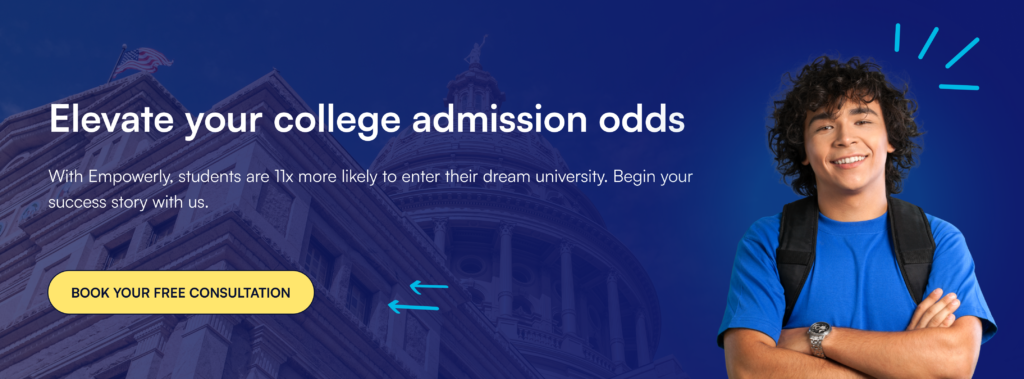Applying to college is a major milestone on the way to adulthood and independence. Of course, as Uncle Ben would say, “with great power comes great responsibility,” and that means taking full responsibility for your decisions. Ready to test your mettle? One of the first big decisions you’ll need to account for in your new educational career is how many schools to include on your college list.
The question is deceptively simple — but there’s a lot on the line. Get it wrong, and you risk wasting precious time, money, and opportunities during one of the most important seasons of your life. But get it right, and you’ll maximize your chances of getting into your best-fit college and launching your dream future.
So what’s the magic number of colleges to apply to in 2025? The answer is both easier and more complex than you might think. Let’s break it down together.
What’s the deal with the college list?
You can think of your college list as a digital shopping cart. As you explore your options, it’s natural to want to add a lot of schools to save and research more later. But just like with online shopping, before you finalize your cart (i.e., your college list), you’ll probably need to carefully narrow down your choices.
There are plenty of ways this process can go wrong if you don’t approach it strategically. For instance, choosing too few schools could limit your options and opportunities. But on the flip side, unless you have a time turner, submitting 50 college applications isn’t the answer either! (Yes, that actually happens.) Applying to too many schools can lead to burnout, lower-quality applications, missed deadlines, and more time and money spent than necessary.
You’ll need a more balanced approach to win the long game of college admissions. So, where’s the sweet spot when it comes to the ideal number of schools to apply to? The key is finding that middle ground that maximizes your chances without creating unnecessary stress or financial burden.
The magic number: how many colleges?
Most college counselors — including the team at Empowerly — recommend applying to around 6 to 8 colleges for the average student. If you’re aiming for ambitious or highly competitive colleges, you might consider applying to more (10+), provided you have adequate application support to help you complete everything on time.
Here’s how the average 6-8 college list typically breaks down:
- 1-2 “safety” schools, where your academic credentials are above the school’s average.
- 3-5 “target” schools that are a good match for your qualifications.
- 1-2 “reach” schools that may be a bit of a stretch, but are still worth applying to.
Case in point: a student with a 3.7 GPA, solid extracurricular activities, and no test scores might aim for around 7 schools (2 safety, 4 target, 1 reach) to find balance. On the other hand, a student applying to multiple Ivy-level programs — even with a strong portfolio — might go up to 12 schools to hedge against unpredictable results.
Confused by these terms? Start here. There’s a reason for the labels; this system helps students maximize their chances of admission while keeping the overall application volume manageable. It also encourages variety without spreading yourself too thin across deadlines, essays, and fees.
But is this number right for you?
Of course, the ideal number will always vary depending on your circumstances. That’s where the caveat comes in. When it comes down to it, the number is slightly different for each student. In other words, there’s a lot to consider before we can give you a simple answer!
The real answer: it depends on you
Let’s take a closer look.
While there’s no one-size-fits-all answer, there are certain things we typically discuss to figure it out. Your personal context matters — academics, finances, interests, and even geography can all influence your ideal number.
To help narrow it down, ask yourself:
- Can I afford the application and testing fees for my list?
- Do I have time for all the essays and requirements?
- Is my list balanced (not all reach or all safety)?
- Have I talked to a counselor or looked at data to back up my idea of culture fit?
Once you’ve confirmed each of those steps, you’ll be closer to your final number. Then, before you lock in your list, consider the following key factors.
Academic profile
Your grades, test scores, and course rigor will shape how competitive you are at various schools. If your academics are on the lower end or even borderline for most of your schools, you may want to apply to a few more target and safety options to protect against surprises. Conversely, if you’re a stellar student, you can likely get away with a few more reaches.
Do you know where you stand? It’s not just a guess of your odds (because that’s risky, too). Use tools like the Empowerly Score® or the Common Data Set resources to benchmark yourself against admitted students at each college for a better perspective.
Financial situation and/or constraints
Applying to college is expensive, with application fees ranging from $50 to $90 per school. Add in SAT/ACT score reporting and other fees, and the price adds up fast.
How fast, you ask? Applying to 12 schools could easily cost $1,200 in application and testing fees alone. Even with fee waivers, you’ll spend significant time on the application components and possibly even travel for multiple visits. A smaller list can help minimize these costs.
If your budget is tight:
- Focus on a leaner list of high-fit schools.
- Definitely research application fee waivers — many colleges offer them.
- Prioritize schools with strong need-based or merit aid options for students.
Planning early and working with experts like Empowerly can help you avoid surprise costs and plan for a more stable financial future.
Application requirements
Just like the campuses they represent, not all applications are created equal.
Some colleges only require the Common App and a personal statement. Others may demand multiple supplemental essays, videos, portfolios, interviews, or other elements that add to the time and effort needed to complete. Want to apply to 15 schools? Be prepared to write 40+ essays.
A long list may sound good — until it’s finals week and you’re trying to write 10 unique and insightful essays off the top of your head. Each application can take 5-10 hours between essays, recommendation coordination, and forms. That means 15 schools could easily add up to 100+ hours — the equivalent of a part-time job during senior year!
To combat this huge drain, keep your list manageable. A smaller list can help ensure you devote sufficient attention to each application.
Your intended major
Certain programs, like engineering or nursing, are more competitive than others, even at the same school. That’s important to consider, as well. If this is you, your list may warrant a few extra reach or target school applications to help you cast a wider net if you’re set on applying to impacted majors.
Geographic preferences:
If you have a strong regional or state preference, you may be able to trim down your list. But if you’re open to a wider range of locations, you’ll likely need to apply to more schools.
Use this opportunity to define your non-negotiables: urban or rural? Large or small? Research-heavy or liberal arts-focused?
For help thinking through your priorities, check out Empowerly’s Guide to Understanding the College List and check out the free ebook PDF you can download there.

The risks of too few (or too many) applications
Let’s talk about what can go wrong, because strategy matters as much as quantity.
Too few colleges
Applying to only 2-3 colleges might seem efficient, and it works for some. But it puts you at serious risk of a negative outcome. A sudden test score drop or single essay mishap could derail everything. Worst case scenario, you might not be admitted to any school on your list, or financial aid packages might disappoint, leaving you with limited viable choices.
Don’t believe me? You can hear it directly from a former admissions officer:
This approach often stems from overestimating your odds or underestimating how unpredictable admissions can be in this day and age. Your best defense? Knowing what you’re up against and staying realistic.
Too many colleges
At the other extreme, applying to 30-40 schools can backfire, too. The more you complete, the harder it is to demonstrate genuine interest in each application — which, believe it or not, is something many schools track. Not to mention, you may experience burnout and compromise on quality when your submissions become rushed and generic.
More isn’t always better. You need to find the right number, not just the maximum load you can handle before you break down.
How to build a smart, balanced college list
Creating a smart, strategic list of colleges isn’t about guesswork—it’s a data-informed, values-driven process.
Here’s how to do it right.
Start with some good old-fashioned self-reflection
Before you dive into rankings or search filters, pour yourself a steaming cup of tea and ask yourself:
- What kind of academic experience do I want?
- What size campus feels right for me?
- What kind of community do I thrive in?
- What’s my long-term goal after college?
This is where working with an Empowerly counselor can be incredibly helpful. They’ll help you clarify priorities and translate goals into specific college matches.
If you want a leg up, go ahead and download our College List Worksheet (below) to help you cover the bases.
Use data — but please, don’t obsess over rankings
Rankings can offer insight, but they aren’t the whole picture.
Focus instead on:
- Admission rates for your intended major
- Average GPA and test scores
- Retention and graduation rates
- Internship and job placement data
Instead of asking, “How prestigious is this school?” ask, “How well does this school support students like me?”
Update as you go
College lists aren’t static. You can — and should — adjust your list based on:
- New test scores
- Changes in your major or interests
- Campus visits or virtual info sessions
- Financial aid updates or scholarship news
Stay flexible. Just make sure your final list still reflects balance and intention.

Don’t leave it up to chance
Ultimately, there is no “perfect” number of colleges to apply to for every student. But there is an ideal number for you, based on your goals, academic profile, financial needs, and how much time and energy you can realistically commit. The right number of colleges to apply to in 2025 will be the one that gives you the best chance of getting into your dream school, without creating unnecessary stress or financial burden.
Above all, remember this: the quality of your applications matters more than the quantity. And with the right strategy and support, you can carefully build a balanced college list that will maximize your odds of admission success.
Want expert help building your college list?
Empowerly’s counselors are standing by to help design a list that aligns with your goals, strengths, and budget. We’ll guide you through every step of your college application strategy, from choosing schools to hitting submit. Book a free consultation today — and build your list the smart way before deadlines start piling up.
